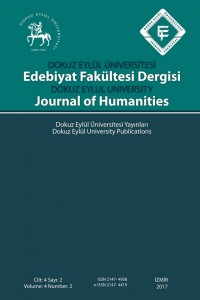Araştırma Makalesi
Yıl 2017,
Cilt: 4 Sayı: 2, 53 - 70, 27.10.2017
Öz
This paper discusses the notion of Icelandic sublime with reference to a number of
subjects identifiable or comparable with it including its relation to Romanticism,
Cartesian physical-mental schism which tends to be conciliated in Icelandic case,
Freudian pleasure principle which asserts itself in the elimination of evocatively
nature-culture dichotomy, and the 19th century versatile intellectual William Morris
for whom Iceland stood as the most exquisite available embodiment of his socialistmedievalist
Arcadia. In this respect, the paper displays an interdisciplinary outlook
as it draws on various fields inclusive of history, philosophy, folklore, languageliterature,
and last but not least psychoanalysis.
Anahtar Kelimeler
Kaynakça
- Aho, Gary. “William Morris and Iceland,” Kairos, Vol. 1, No. 2, 1982, pp. 102-133. Baudelaire, Charles. The Painter of Modern Life. Trans. P. E. Charvet. London: Penguin Books, 2010. Berkeley, George. The Principles of Human Knowledge. Glasgow: William Collins, 1981. Castle, Terry. Introduction. The Mysteries of Udolpho. By Ann Radcliffe. Oxford: Oxford University Press, 2008. Chew, Shirley and Alistair Stead (eds.). Translating Life: Studies in Transpositional Aesthetics. Liverpool: Liverpool University Press, 1999. Cole, G. D. H. Introduction. William Morris: Selected Writings. Ed. G. D. H. Cole. New York: Random House, 1934. Cook, Robert. Introduction. Njal’s Saga. Trans. Robert Cook. London: Penguin Books, 2001. Dacre, Charlotte. Zofloya, or the Moor. Oxford: Oxford University Press, 2008. Descartes, René. Discours de la Méthode. Paris: Flammarion, 2000. Freud, Sigmund. Beyond the Pleasure Principle. Trans. James Strachey. New York: Norton, 1961. Gibbon, Edward. The Decline and Fall of the Roman Empire. New York: Modern Library, 2003. Greenblatt, Stephen, gen. ed. The Norton Anthology of English Literature. 9th ed. Vol. 2. New York: Norton, 2012. Hamilton, Edith. Mythology. New York; Boston: Grand Central Publishing, 2011. Hastrup, Kirsten. A Place Apart: An Anthropological Study of the Icelandic World. Oxford : Clarendon Press ; New York : Oxford University Press, 1998. Huizinga, Johan. The Waning of the Middle Ages. Trans. F. Hopman. London: Penguin Books, 1955. Kramnick, Isaac, ed. The Portable Enlightenment Reader. New York: Penguin Books, 1995. primär, ist das Prius des Organismus und dieser durch ihn bedingt.” (Schopenhauer Denken 33). Kumar, Krishan. Introduction. News from Nowhere. By William Morris. Cambridge: Cambridge University Press, 1995. Lucretius. On the Nature of Things. Trans. Martin Ferguson Smith. Indianapolis: Hackett Publishing Company, 2001. Montaigne, Michel. The Complete Essays. Trans. M. A. Screech. London: Penguin Books, 2003. Morris, William. Useful Work v. Useless Toil. London: Penguin Books, 2008. Morris, William. The Collected Works of William Morris Volume VIII. London: Routledge/Thoemmes Press, 1992. Plato, Aristotle, and Horace. Classical Literary Criticism. Trans. Penelope Murray and T. S. Dorsch. London: Penguin Classics, 2004. Sawyer, Peter. Kings and Vikings: Scandinavia and Europe, A.D. 700-1100. London; New York: Routledge, 1989. Schopenhauer, Arthur. Denken mit Arthur Schopenhauer. Ed. Otto A. Böhmer. Zürich: Diogenes, 2007. Schopenhauer, Arthur. The Essential Schopenhauer. Ed. Wolfgang Schirmacher. New York: Harper Perennial, 2010. Sturluson, Snorri. The Prose Edda. Trans. Jesse L. Byock. London: Penguin Books, 2005. Thoreau, Henry David. Walden; or, Life in the Woods. New York: Dover, 1995. Vico, Giambattista. New Science. Trans. David Marsh. London: Penguin Classics, 2013. Wawn, Andrew. The Vikings and the Victorians: Inventing the Old North in Nineteenth Century Britain. Cambridge: DS Brewer, 2000. Wong, E. David. “The Rebirth of Cool: Toward a Science Sublime,” The Journal of Aesthetic Education, Vol. 41 No. 2, Summer 2007, pp. 67-88.
Toplam 1 adet kaynakça vardır.
Ayrıntılar
| Birincil Dil | İngilizce |
|---|---|
| Bölüm | Makaleler |
| Yazarlar | |
| Yayımlanma Tarihi | 27 Ekim 2017 |
| Gönderilme Tarihi | 1 Ocak 2017 |
| Yayımlandığı Sayı | Yıl 2017 Cilt: 4 Sayı: 2 |


